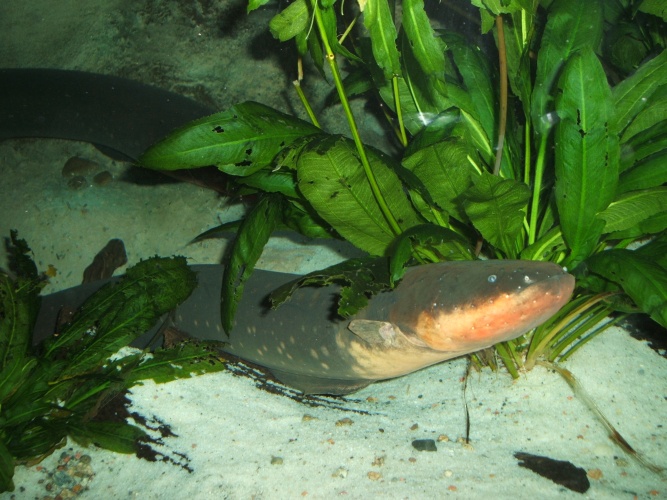
(Credit: Steven G Johnson via CC)
Electric eels combine potassium and sodium ions in cell membranes to deliver their trademark jolt. Mimicking that system, the researchers used the sodium and chloride constituents of salt, dissolved in a hydrogel. Thousands of tiny droplets of the salty gel were printed on a plastic sheet, alternating them with hydrogel droplets of pure water. The team then created a second sheet of alternating droplets made of charge-selective hydrogel. Each droplet allows either positively charged sodium or negatively charged chloride to pass, while at the same time excluding the other.
When the sheets are pressed together, the salty and fresh solutions mix, the charge-selective droplets move the sodium and chloride ions in opposing directions, and an electric current is produced. The work, published in Nature, featured input from scientists and engineers from the University of Michigan, the Adolphe Merkle Institute at Switzerland’s University of Fribourg, and the University of California-San Diego.
“The eel polarises and depolarises thousands of cells instantaneously to put out these high voltages," said study co-author Max Shtein, associate professor of materials science and engineering at Michigan. "It's a fascinating system to look at from an engineering perspective - its performance metrics, its fundamental building blocks and how to use them."
One particular challenge was aligning the alternating cells in the correct order so that they created a current when brought together simultaneously. The team solved this problem with an origami technique called a Miura fold, often used to fold solar panels into satellites for launch. The different droplet types were alternated in a precise pattern on a flat sheet that had been laser-scored in a Miura pattern. When pressure was applied, the sheet quickly folded together, stacking the cells in exactly the right positions.
According to the researchers, the goal is now to improve the device’s efficiency, with a view to one day using it to power implantable or wearable electronics. There is also a belief that the hydrogel battery could potentially be powered up using the body’s own bioelectric processes, much like the eels that inspired the original concept. But while an electric eel can deliver up to 600 volts, the hydrogel system is a lot less powerful.
"The electric organs in eels are incredibly sophisticated; they're far better at generating power than we are," said Michael Mayer, a professor of biophysics at Fribourg’s Adolphe Merkle Institute. "But the important thing for us was to replicate the basics of what's happening."




Poll: Should the UK’s railways be renationalised?
I _do_ remember British Rail - and that it was <i>literally</i> a national joke https://youtu.be/zV2lmSDKvO8